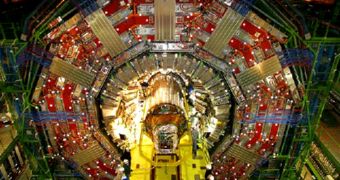Investigators working in Europe, at the world's largest particle accelerator, say that they are zeroing in on the source of dark matter, the mysterious stuff believed to make up 23 percent of the mass of the Universe, but which is apparently impossible to detect.
Physicists have had a much better year than originally expected. Studies conducted with the three main particle detectors at the Large Hadron Collider (LHC) have yielded very interesting results.
The research facility is situated at the French-Swiss border, and is buried as much as 175 meters (574 feet) beneath the city of Geneva. It is operated by the European Organization for Nuclear Research (CERN).
Due to its amazing superconducting magnets, and also to its 27-kilometer tunnels, the particle accelerator can produce collisions at a maximum energy level of 14 teraelectronvolts (TeV), or 7 Tev per individual particle beam.
The Compact Muon Solenoid (CMS) is one of the three primary instruments at the Collider, and its operators say that their work is about to yield some major findings. The results were obtained as protons were collided head-on inside the Solenoid, at nearly the speed of light.
When this happened, the chamber hosted conditions that were nearly identical to the ones at the time of the Big Bang. This is the event that created the Universe more than 13.7 billion years ago, experts say.
The reason why such experiments are being carried out is because they can lead to the production and subsequent detection of brand-new particles, that have not existed since the Cosmos was born.
Using these data, the CMS physics team hope to be able to finally uncover evidence that supersymmetry exists. This phenomenon would be an extension to the Standard Model of particles.
“We have made an important step forward in the hunt for dark matter, although no discovery has yet been made,” explains Imperial College London (ICL) Department of Physics professor Geoff Hall.
“These results have come faster than we expected because the LHC and CMS ran better last year than we dared hope and we are now very optimistic about the prospects of pinning down Supersymmetry in the next few years,” he goes on to say.
Dark matter is related to supersymmetry directly, in the sense that the lightest possible supersymmetric particles (sparticle) is a candidate for dark matter.
A number of propositions have been set forth over the years, in an attempt to explain the stuff, but most of them have failed to pin down the elusive form of matter, Universe Today reports.

 14 DAY TRIAL //
14 DAY TRIAL //